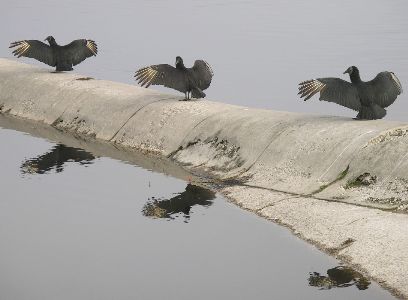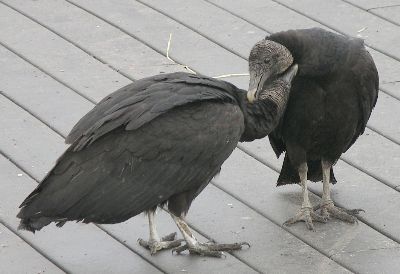
|

|
We most frequently see vultures as they soar overhead, effortlessly circling in updrafts and scanning the ground for their next meals. They are elegant flyers, and their black silhouettes against the sky are so familiar that we'd miss them if they were absent. When not nesting, vultures like to roost at night in large groups, preferably in a safe place such as a large tree or, in urban areas, a huge high-tension wire tower. At the intersection of Hwy. 360 and Mopac, there is such a power line structure. When I was commuting to work in the mornings, it was always cheery to see the vultures starting to warm themselves by spreading their wings to catch the rising sun. On cold, misty days, they would all just hunker down and stay put. A year or so ago, the utility company put small twirling objects on the scaffolding, presumably to scare the vultures away so they wouldn't roost there. It worked for a few months, but the birds have now learned that the decorations are no threat and have returned to their usual hang out.

|

|
While seeing the birds at a distance is pleasant, it is much more exciting to have a closer encounter. They are bigger than one expects when viewed from an eye-level vantage. Hiking up one of the side channels of Barton Creek, I was almost hit in the head by a vulture taking off from a rather low nest in a small cliff. I've also come across vultures that don't want to leave their precious meals and so will stand their ground even when approached rather closely. At these times, I give them wide berth, since these birds are known to vomit when alarmed, and I don't really want to see what they've just swallowed.
One of the most enjoyable places I've watched vultures is at Myakka River State Park in Florida. There is a large flock of black vultures that roosts in the trees near a boat ramp. In the mornings, which are often foggy, especially in the winter, the black vultures commandeer not only the park benches and small dam, but even the observation deck. As they wait for the sunshine to warm them up, they interact just like any other animals with too much time on their hands (or wings): squabbling, preening, and even courting each other. While not quite as attractive in our view as doves or lovebirds, a pair of affectionate black vultures can still warm the heart.
